If you’re anything like me, your geekiness knows practically no bounds. I am way into a bunch of different fandoms across many genres, and these days I feel super lucky because of all the outlets I have whether it’s movies, TV shows, gaming, novels, comic books, and so much more. Among my absolute favorite things in science-fiction and gaming are the classic cartoon series Robotech, models and hobbying, and fast-paced miniatures games. And that is precisely why I was so excited when I heard about the new project from Kids Logic! The company has already been producing incredible Robotech collectibles, both ultra high-end statues and electronics and more recently the MiniTech line of incredible Robotech resin miniatures. Only recently announced is a brand new game utilizing those models, Robotech MiniTech Macross Dog Fight The Miniatures Game. The people at Kids Logic were kind enough to send over an early sample of the game, and I’m really excited to show you what it’s all about. Read on!

If you aren’t immediately familiar with Robotech, let me quickly bring you up to speed. It’s an American animated series that’s a Frankenstein’s Monster created from splicing together three WHOLLY UNCONNECTED Japanese anime with new stories, interconnected and related characters, and a healthy dash of ambitious ‘80s magic. Robotech is also a lightning rod; those who know it either love it (usually having grown up on it and other early Japanese animation in the U.S.) or hate it because it’s not “true” to its original component series Macross, etc. The first, and by far most famous, storyline in Robotech is based on the Macross anime and features humans piloting transforming robot/fighter plane Veritechs (Valkyries) against the gigantic alien Zentraedi. The franchise has also had its ups and downs over the years with long stretches of no new products interspersed with frantic eras of licensing, rumors, partnerships that don’t always work out, and broken dreams. Thankfully, a few really cool companies have stepped up in recent years to take on the Robotech license, and that leads us to Kids Logic.
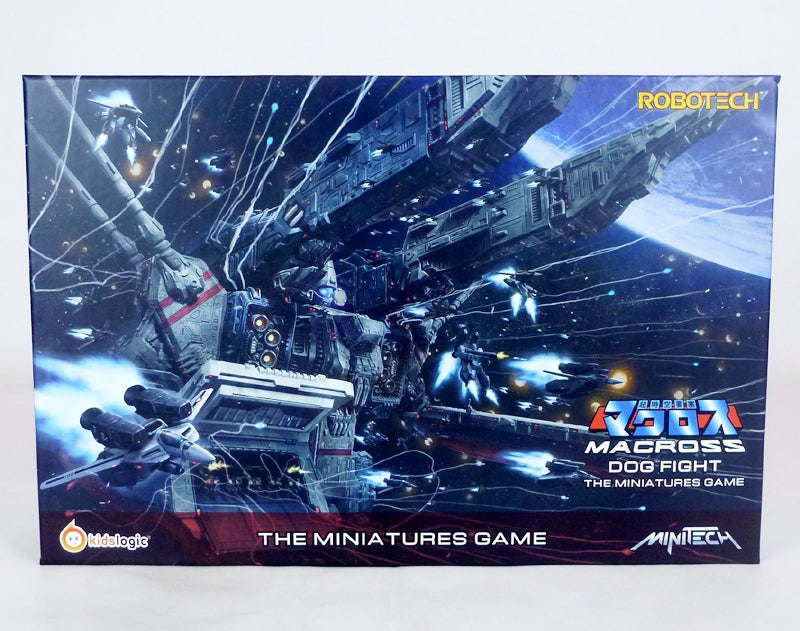
Kids Logic came onto the scene in 2009, creating innovative products out of their headquarters in Hong Kong. They’ve had the Robotech license now for a number of years and became famous worldwide for their unique expressions like the 1/6 scale VF-1 Cockpit Statues, 1/8 scale VF-1 Mechanical Bust Statues, ¼ scale statues, and the mind-boggling 1/1200 scale SDF-1 Macross Diorama Vacuum Tube Digital Sound System. In 2019, though, there were rumblings around the internet of Kids Logic getting into something a bit smaller. Without going into the full and sordid history, a few years prior Palladium Books created a Robotech miniatures game via Kickstarter… and it ended in some very awkward and not super detailed miniatures being produced, many promised models unproduced, and lots of hard feelings among fans. So, when Kids Logic appeared to be working on highly detailed, resin models, well, lots of people like me were very keen to find out more. In 2010 Kids Logic unleashed the MiniTech line, and there were celebrations far and wide. These Robotech miniatures are incredibly detailed and feature a frankly shockingly small parts count making them a snap to assemble. Not only that, but Kids Logic quickly caught up with models Palladium had released and soon surpassed them with mecha we had only dreamed of. And yet, for a while it appeared that these were just cool models without a game system tying them together. Until now.
Important note: this is an early sample of the Macross Dog Fight Miniatures Game. It came with a photocopied early rule book, and so it is subject to change before the final version is released. Kids Logic is continuing to fine tune and perfect the game system, and of course everything will be completely polished by the time it’s available for purchase.

Okay, let’s get to it. First off, the box is rad and features absolutely glorious artwork that we’ve learned was produced by Studio HIVE out of Thailand. The front panel is entirely an action shot of Veritechs exploding out of the SDF-1 as it fights for humanity in space, with missiles swarming everywhere. Then of course you’ve got all the requisite logos and titles, notably both Robotech and Macross. The sides of the box continue the rad artwork with the Zentraedi Officer’s Pod on one and a Super Veritech on the other. Now, the back is where things get really interesting, and where we first got a sense of how this game actually works. We can minis, bases and movement templates, a bunch of different kind of cards, tokens, and more. There’s a brief, action-filled description of the gameplay and then a comprehensive list of the box’s contents, which I’ll go over below. From a packaging standpoint, Dog Fight is already an A+ and looks great.
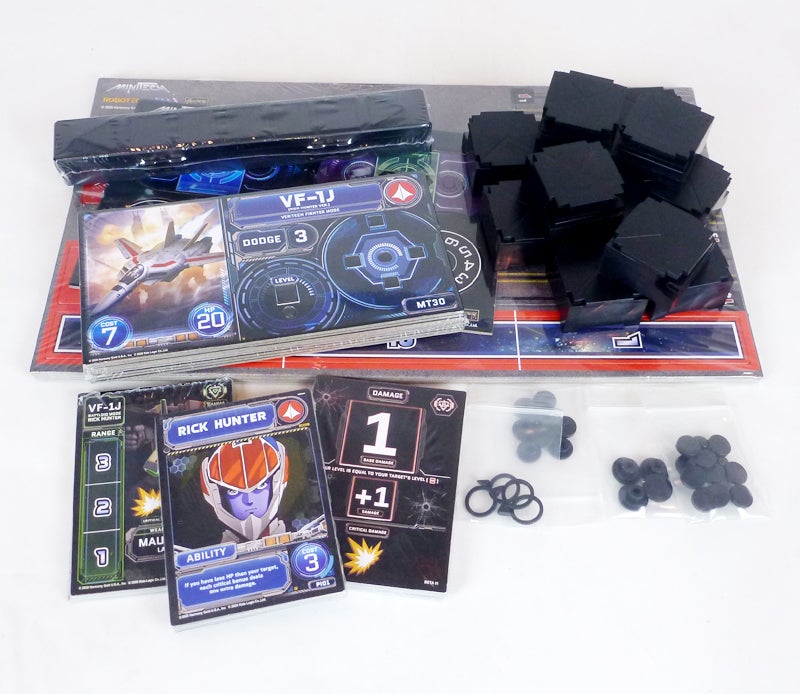
So, what’s inside? A lot! Most people will be most interested in the four models (and I’m going to talk about those specifically below), their component sprues held safely in individual cells within a big plastic tray and held firm with foam padding. Then there’s the rule book, in this case a photocopied sample. Plastic components include stacking Stand Bases and Missile Aiming Panels, while heavy cardboard stock panels have punch out Flight Path Templates, Weapon Range Rulers, Control Panels, HP Counters, Ammunition Tokens, Dodge Tokens, and Position Markers. In standard card format are Pilot Cards, Cross Event Cards, Weapon Cards, and Damage Cards. Finally, there are some tiny plastic parts for assembling the Control Panels. Overall, everything has a pretty good feel, definitely good with respect to graphics and ease of reading. I would definitely recommend sleeving your cards to protect them from wear, as they and things like the Flight Path Templates are a little on the flimsy side.
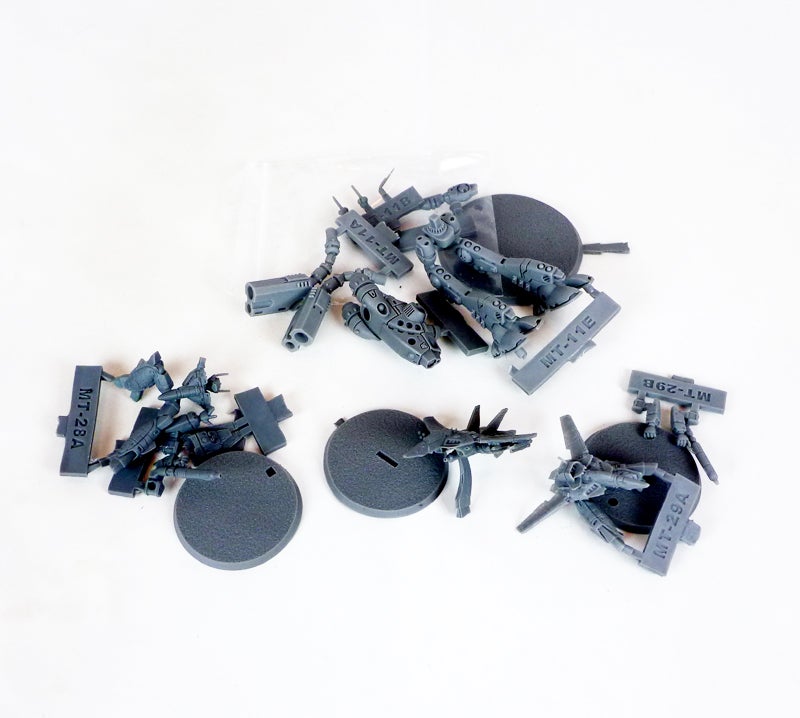
Before you can think about learning and playing the game, you’ve got models to build! As noted above, there are four of them in this box. On the Zentraedi side is just the one, Khyron’s Glaug Officer’s Pod. Opposite that is a trio of models for Rick Hunter’s VF-1J Veritech. You get a model for each of the mecha’s three modes, so Fighter, Guardian, and Battloid. The Pod is straight out of the regular MiniTech line, #11 which is currently available individually. The VF models are marked #28, 29, and 30; at the time of this writing those are not yet announced for individual sale, but I have to assume they will be. As the original anime was produced in the early ‘80s, the Veritech (Valkyrie) was heavily influenced by the U.S. F-14 Tomcat. In fighter mode the VF-1 has twin engines, swing wings, an underslung gunpod, and hardpoints for missiles under its wings. The Battloid configuration sees the craft transformed into a giant humanoid robot with the engines becoming the feet and legs while arms and a head appear! Guardian is an in-between mode, essentially a jet with arms and legs. Pilots of different ranks get VF models with different head styles, and here as Rick Hunter is a squad leader he has a VF-1J with distinctive twin head lasers. Each mode has its benefits and drawbacks, but they all look super cool. Meanwhile, the giant Zentraedi use “pods” to wage war, and while the standard version is basically an egg on legs, the Officer’s version has a sleeker cockpit, powerful legs, and a suite of weapons including cannon arms and an overhead heavy beam cannon.
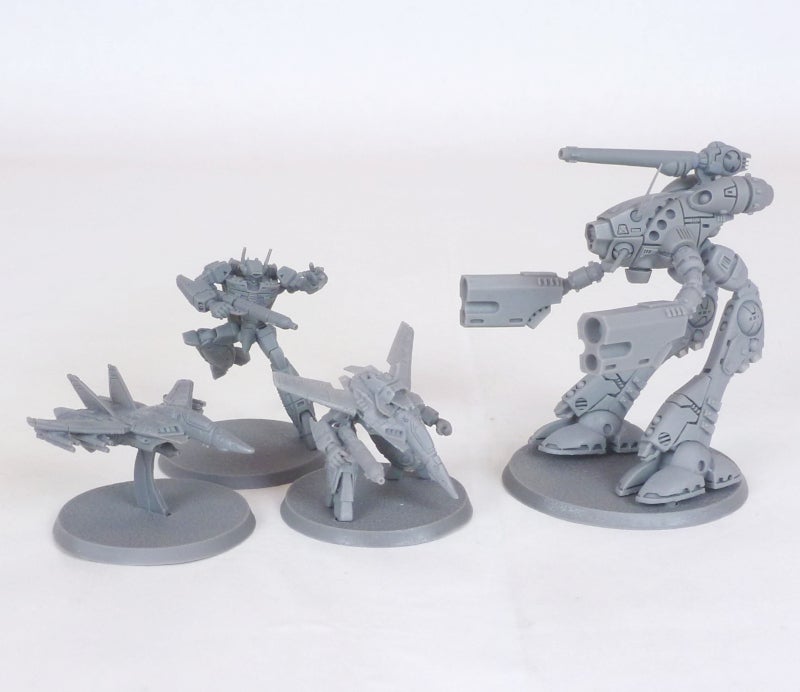
A couple important notes here. First off, these are resin models, and as such require a degree of attention in building and some specific tools. Resin is a hazardous material, and you must take certain precautions. In its fully cured form it’s not especially dangerous, though if you were to drill into it or sand it, it would produce fine particles you should not inhale. You’ll also need super glue to build the models; there are lots on the market from big name companies like Loctite and Gorilla Glue to hobby store cyanoacrylate formulations. I would love to see Kids Logic include even a small pamphlet or link to a website where people can get a tutorial on resin handling. There are also no build instructions, though it’s pretty apparent where everything goes even just from the artwork on the box and in the rule book.
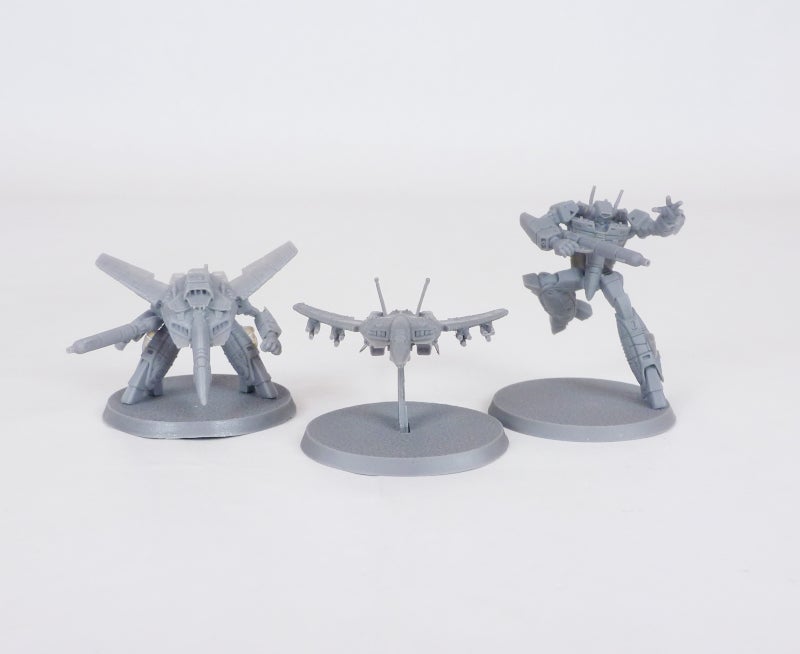
I already owned a handful of MiniTech models, so I had an idea of what I was getting into, but these models are really cool with just extraordinary craftsmanship. On the models here I had a tiny bit of trimming and cleanup to do, but otherwise, they were ready for assembly right out of the box (though you need to wash your resin first!). In general, any attachment points are sculpted to link in a specific way, though there are some options for posing especially if you trim away the pegs. After washing the parts and doing the cleanup work I assembled mine with a combination of glue and sticky tack; as I plan on painting my minis, I can’t attach everything permanently just yet, and I experimented with different posing for the VF-1J Battloid’s arms. I should have an update to this article featured my completed models soon!
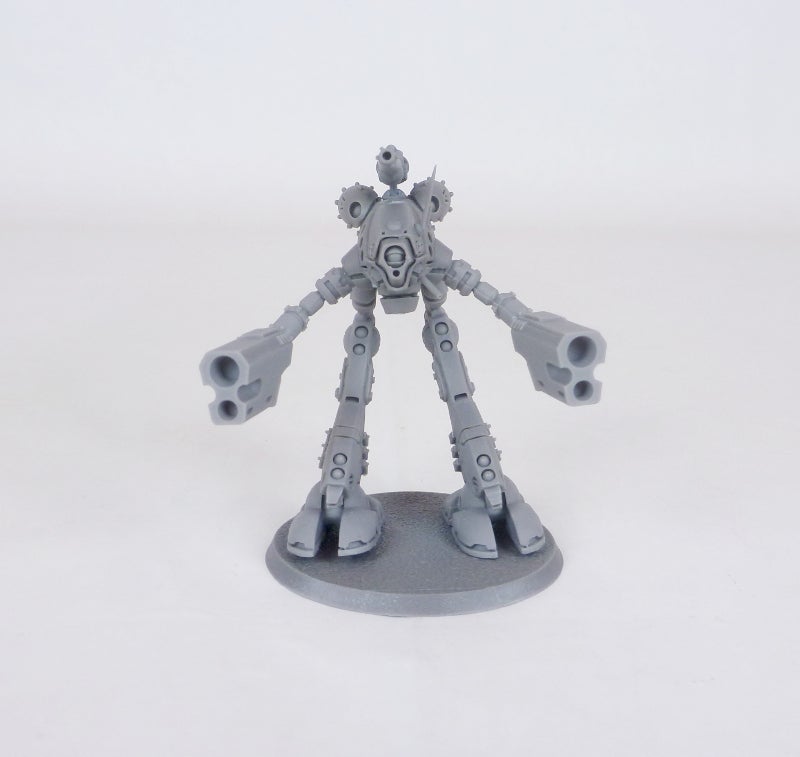
I’ve been a fan of Veritechs since I was 6 years old, and they’ll never cease to be cool to me, but I have to admit I was really impressed by this Officer’s Pod model. It’s appropriately huge compared to the human craft, and that bulk leaves room for a lot of fantastic detail and deep cuts. When building this one you can pose the arms a bit, though they really should just point forward. The three Veritech models are small, to be sure, but they are great. And again, in comparison to the Palladium miniatures that consist of more than a dozen parts it’s crazy to get a jet mode VF-1J that’s only one piece, and a Guardian and Battloid that are three and four respectively. Again, if you’re an experienced hobbyist you might be able to manage some unique posing on the models with arms, though they look great as intended. Kids Logic has had VF-1Js in the MiniTech line before; these are unique with missiles on the hardpoints of the jet mode, a low-angled Guardian, and a Battloid that’s posed quite dramatically!
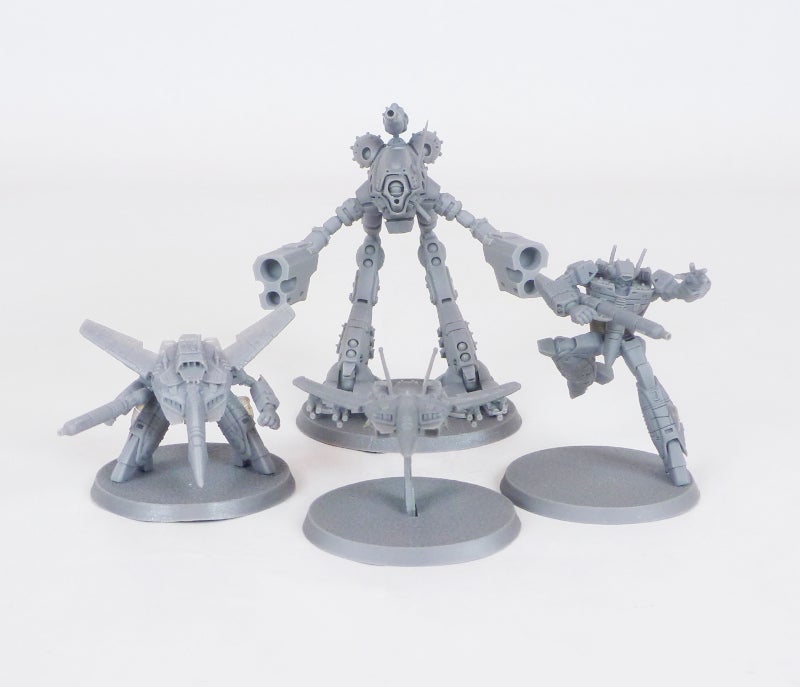
Once you’ve built your models (and hopefully painted them), it’s time to play! First things first, Dog Fight is much more of a board game/miniatures game than a wargame as some were expecting. You won’t be fielding squadrons of units on a huge table. Instead, this game takes some cues from systems like X-Wing (1.0 at least), Star Trek Attack Wing, and Battlestar Galactica. This is most obvious in the movement system, which I’ll get to in a moment. Another big difference between this and most other games is the lack of dice. There are random elements, but they’re achieved mainly through opponents selecting attacks in secret and comparing them or drawing cards from decks.
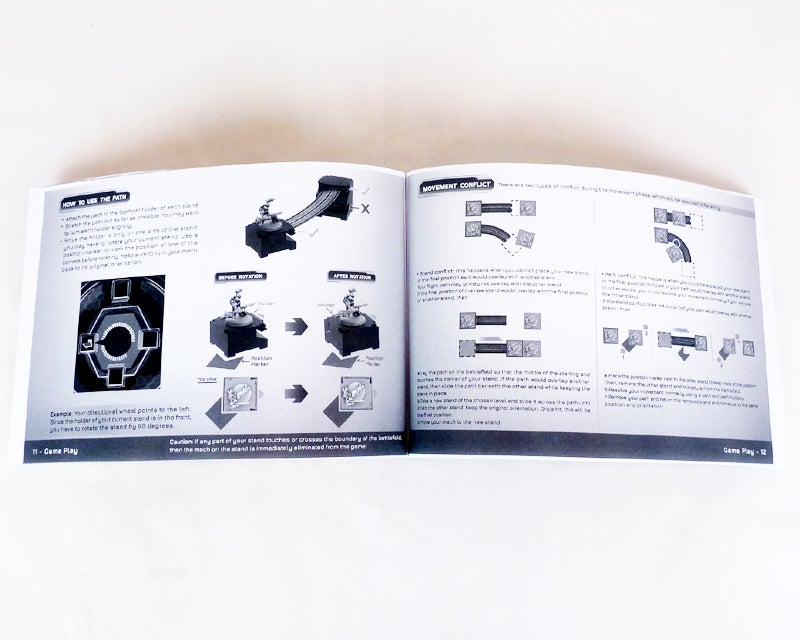
Notably, the instructions and gameplay described in the rule book are very specific to the box, and the only “expansions” it discusses are multiple copies of Dog Fight to allow for more players. Kids Logic has confirmed, however, that they are planning more expansions and content going forward including pilot cards and contents corresponding to already available MiniTech models.
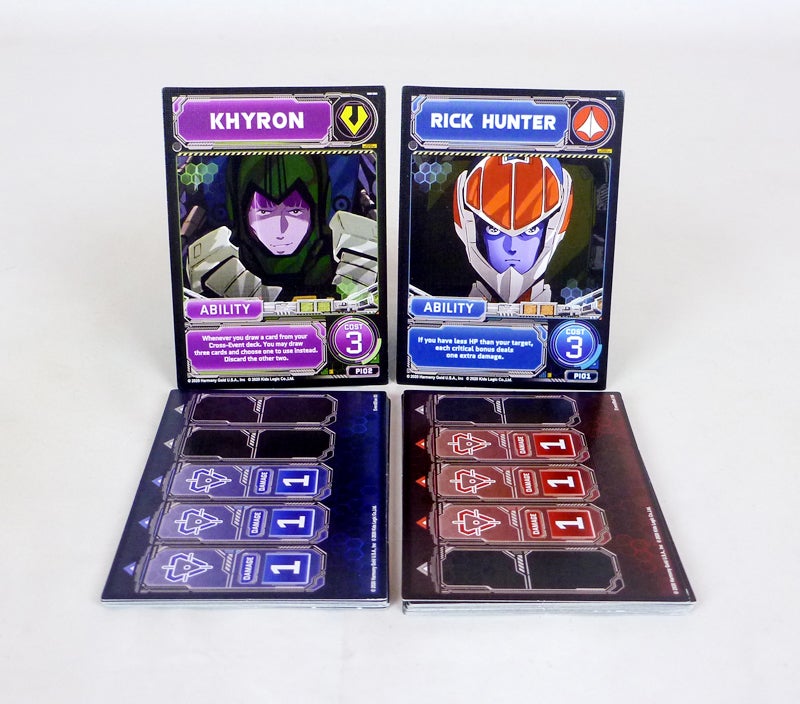
Let’s play a game. After assembling models, popping out, and organizing your contents, it’s time to create the battlefield and build teams. There is no play mat (Kids Logic is looking into producing one); as with other games like Attack Wing, etc., you just need to mark out an appropriate space on a table. There are options for Amateur, Talented, and Veteran game modes based on points totals, though with one copy of Dog Fight you can only play at the lowest level. Your “team” is built simply by drafting a pilot and then a mecha to go along with him, in this case Khyron and Rick Hunter, and the VF-1J and Officer’s Pod. There is no faction matching requirement, so technically you are free to embark the Zentraedi on the Veritech even though that doesn’t make much sense in-universe (unless Khyron somehow agreed to be Micronized) and vice versa. Pick your pilot, grab his card that grants a special ability, and choose your war machine.
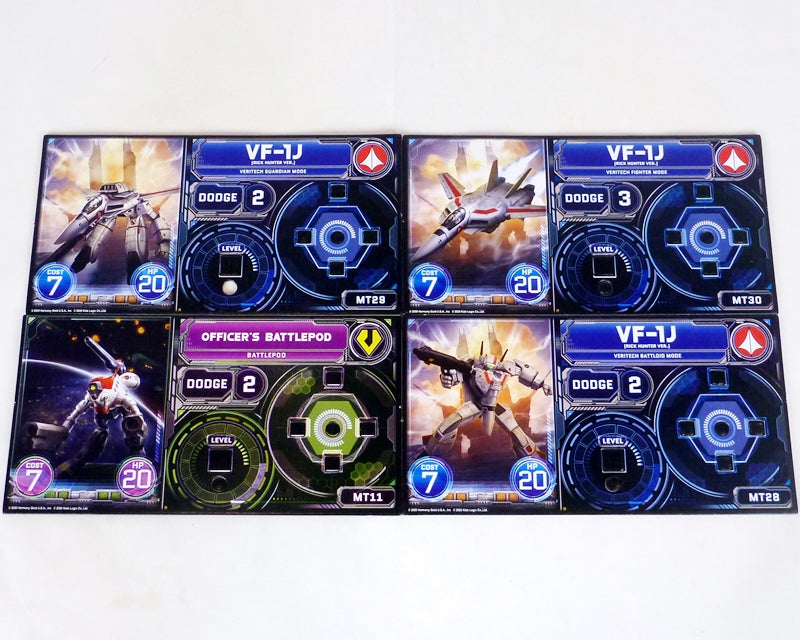
Each form of each mecha has its own Control Panel, a heavy cardboard card with three dials on it. This means that whoever plays the Veritech will need three Control Panels and to switch between them if/when the craft transforms. There are also specific weapon cards for each form/craft, which give you options when making your attacks. Grab those decks too, along with the game components each player gets: Stand Bases, HP counter, Flight Path Templates, Missile Aiming Panel, tokens, and Cross-Event Decks. Both players will share the three different weapon damage decks, range rulers, and position markers. Set up a play space (32” by 32” recommended), start your model on your board edge, and you’re ready to go!
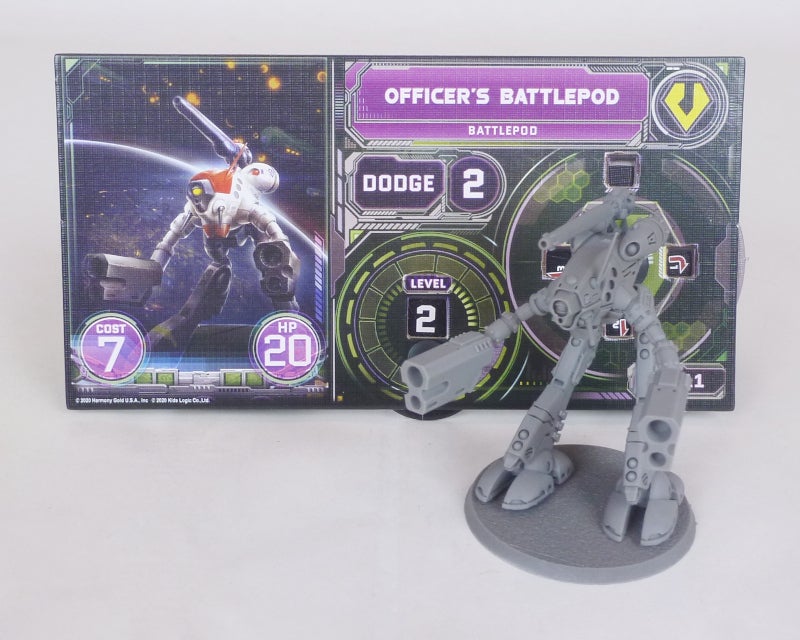
The game moves through mostly standard phases: Planning, Movement, and Combat, with the addition of the Cross Event before the main fighting happens. If you’ve played any of the other games I’ve mentioned, you’ll have a good sense of how the first two work. Secretly set the dials on your Control Panel to determine how your model will move according to the templates, with the added mechanics for direction and elevation (Level). Each Control Panel has its own suite of movement options from short forward moves to sweeping turns and everything in between. Then perform those movements, and potentially transformations, in the Movement phase with the templates attached to the Base Stands (the number of which will correspond to the Level you’ve chosen). Rules govern what happen if movements intersect in various ways. Another way this game differentiates itself is in the fact that both players always act simultaneously! For some players this will take getting used to, and there are suggested rules for any situations in which you might find the need for a specific order of who’s doing what.
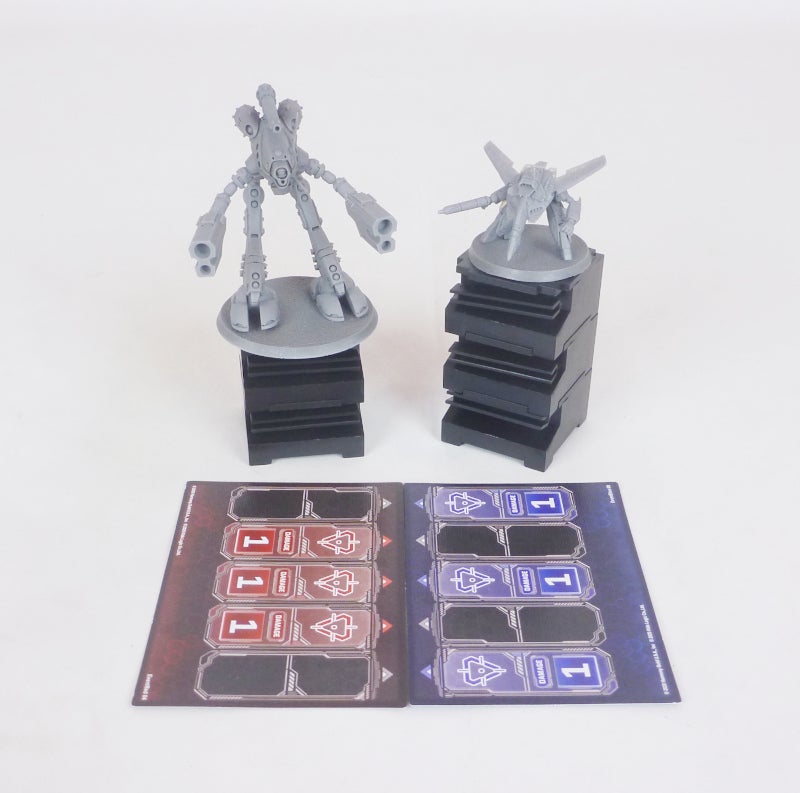
If the movement of the opposing mecha would cross during their moves, a Cross-Event happens! This is a quick snap firing of missiles as the enemies pass each other, and here’s where you use the Cross Event decks. Basically, shuffle and draw one, then line it up to your opponent’s. Match the symbols to see if any of your missiles make it through the opposing barrage, and apply corresponding damage to the HP counter. In this way it’s possible that no one takes damage, one fighter takes some, or both are damaged!
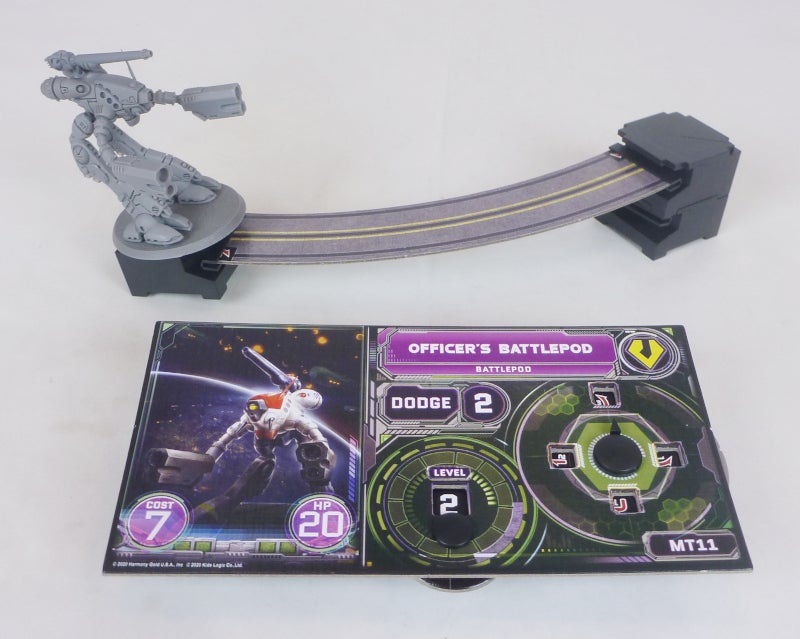
Once that’s out of the way it’s time for the standard Combat phase. Check your firing arc on your Base Stand, measure distance with the ruler, and declare your target. Now, there are a couple of ways combat can go, though they both utilize the plastic Aiming Panels. These are thin, flip open trays with seven slots. If an opponent is shooting at its enemy and that enemy cannot fire back, then it’s a One-Sided Attack. The attacker picks one of the mecha’s available weapon cards to employ and loads three ammunition worth of tokens into the five middle slots on the Aiming Panel as you choose, then both players apply any dodge tokens (all in secret). Then the Aiming Panels are opened and lined up with one another. Dodge tokens will shift their respective Panels left or right, potentially moving ammunition tokens out of the line of fire. Any that are left in the central zone will go through and cause damage.
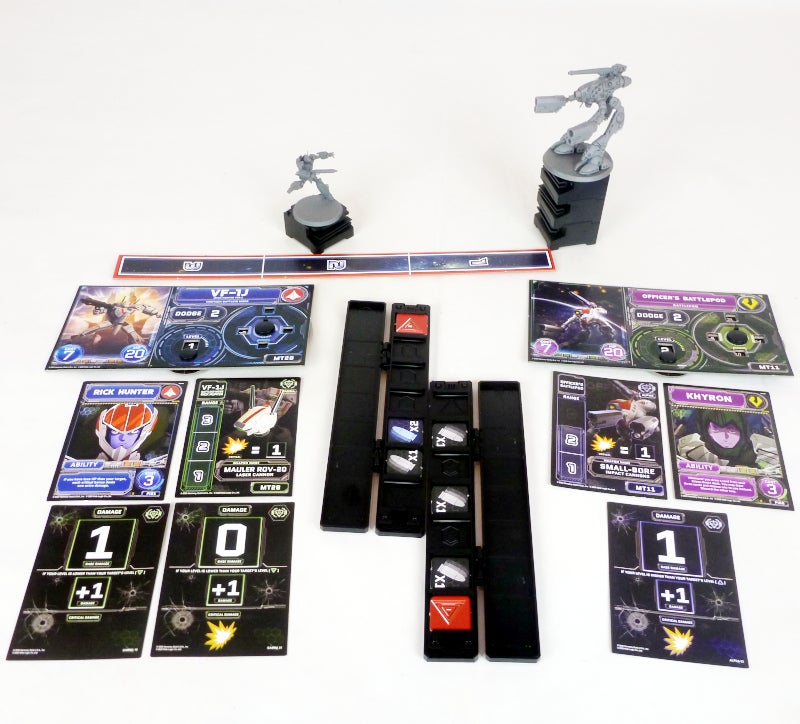
On the other hand, if both combatants are shooting at each other, it’s a Head-On combat! Both players apply ammunition tokens and Dodge tokens, compare, and see what happens. It’s a deceptively simple system, especially because it doesn’t use dice, but there’s a lot of nuance. Ammunition tokens come in 1s and 2s, so you have to decide if you’re going to spread out your shots or concentrate two of them, and then choose the spread on your Panel. Dodges will shift things, and you don’t know if your opponent is playing one at all, or how far it will go in which direction. Then, even once all of that is decided, you check the weapon card that you’re using to see which damage deck to pull from. Weapons have different ranges (some are only usable at close range) and are better in different situations as described by the different damage types. Alpha weapons are ideal for combat in which you are above your opponent, Beta when you’re on the same Level, and Gamma when you are below. The damage cards will indicate how much base damage is done, any bonus for the corresponding Level of combatants, and possible critical damage as described back on the weapon card. It may sound like a lot but it’s quite intuitive once you get playing, and fun as you check where everyone is and pick the best weapon to maximize damage potential! Note, though, that damage cards are drawn at random from their different decks, so while you can pick from the deck that corresponds to the ideal shooting position you’re in, some will deal more damage and some will deal less.
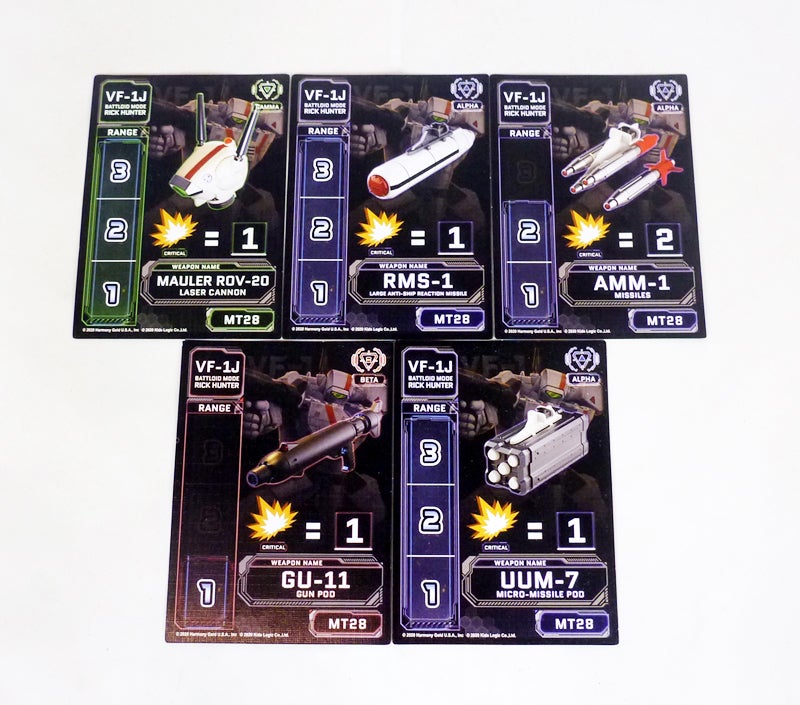
That’s the game in a nutshell: plan moves/elevation/facing, perform your maneuvers, initiate Cross-Event quick duel if it’s called for, and blast away in the combat phase. In the games that I’ve played the two sides in this box are pretty well balanced, with the Officer’s Pod being a little more powerful balanced with the much more flexible Veritech as it can change modes to min/max movement and weapon options. For that reason, I’d say the Veritech is probably better for more experienced gamers at least at first as it’s a lot more to keep track of when you’re playing.
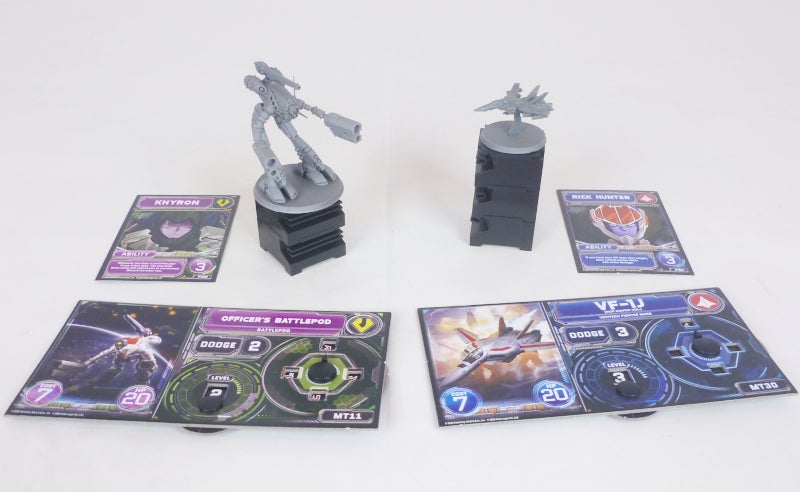
As with all games, the first couple times you play will take a while as everyone becomes accustomed to the rules, but once that happens a game of Dog Fight can certainly be played in 30 minutes or less. It’s fairly swingy with the potential for one player to do lots of damage in a turn and take none (lucky Cross-Event, One-Sided combat with all attacks going through and lucky damage card pulls), though the high starting hit points of 20 helps prevent alpha strikes from being too decimating.
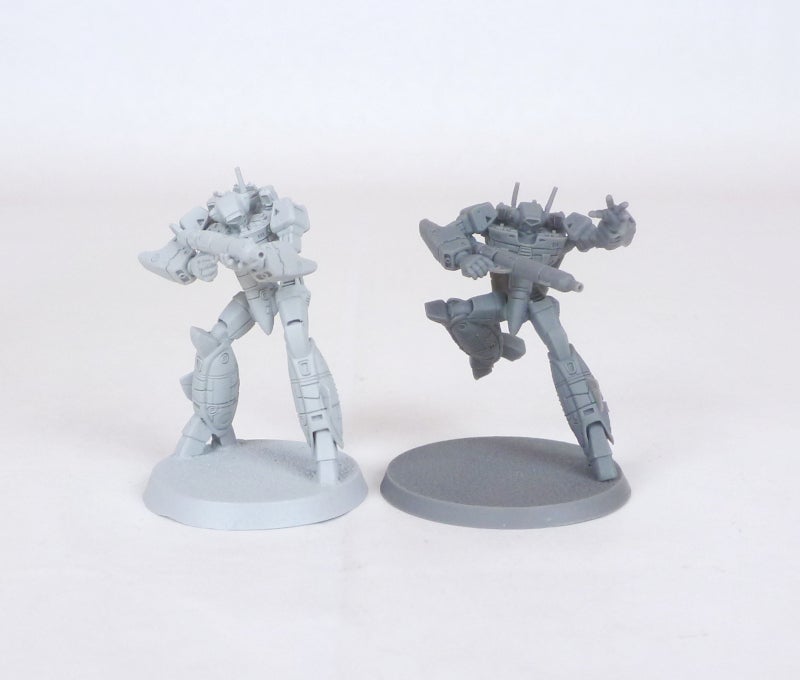
I was already a big fan of Kids Logic’s MiniTech line and while I had to try it out a few times to get over my apprehension of not using dice, I quite like the gameplay of Dog Fight. Of course, the miniatures are top-notch, and the game is quick to learn with a surprising amount of randomness even without any rolling. Plus, it’s just fun to slam down Cross-Event cards and Aiming Panels while envisioning missiles and lasers streaking across the intervening battlefield, some impacting on one another while others make it through to do damage! In addition to expansions, I’d really like to see some rules for terrain, whether that’s buildings and debris or asteroids and the like. I also feel like there’s a missed opportunity for melee combat, though that would require a lot of additional mechanics and features.
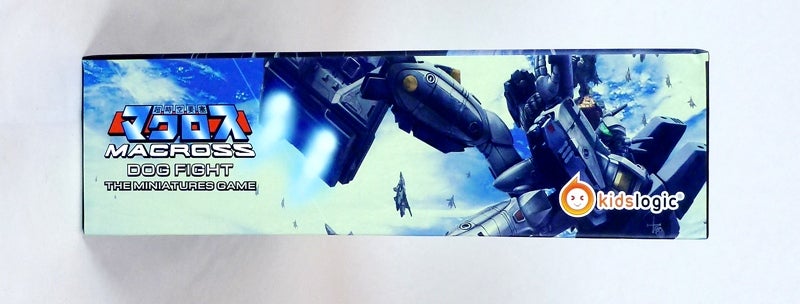
If you’re a Robotech fan and/or a miniatures gamer or collector, I really suggest you check out Dog Fight. It’s definitely not going to be what you’re used to, but it’s great as a fun, quick game that comes with fantastic miniatures. And it’s only going to get better with further expansions and additional content. As of this writing Kids Logic has indicated that preorders for Dog Fight will open about March 20th, and with only the printing of the rulebooks left in production the first batch of copies should start shipping by mid-April! Keep your eyes on the MiniTech website and the Robotech Macross – The Miniatures Game Facebook group to get the latest news on the game and the model line. Of course, we here at Figures.com will be sure to share the announcements as well!
Review and photos by Scott Rubin.
Review sample courtesy of Kids Logic.

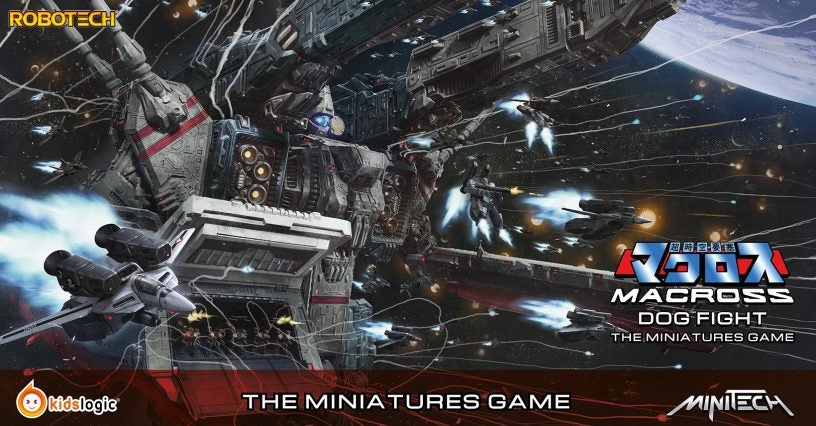
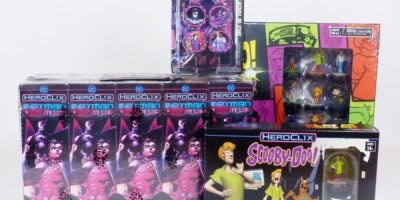
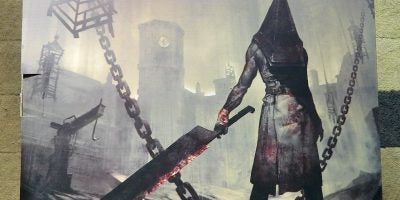
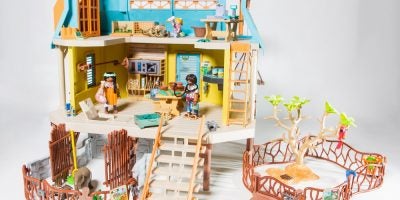

 Your Privacy Choices
Your Privacy Choices
Leave a Reply to Cancel reply